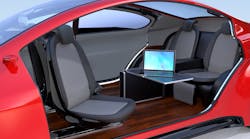The short answer is never say never, but it will be quite some time before drivers (especially those who enjoy it) are willing to give up the wheel.
This was a topic of conversation during one of Altair’s panels during its recent three-day Future.Industry event.
One of the painful transitions to an electric vehicle- (EV) centric world is a lack of charging infrastructure, Robert Llewellyn, actor and host of "The Fully Charged EV Show," pointed out. He provided an example in which a charging station housed 14 Tesla superchargers, but now there additional charging stations for all other EVs.
“It is getting better,” he said. “It used to be diabolically, appallingly bad.”
We don’t have to build up everything from scratch, though. Building innovation on top of innovation and using technologies already present is crucial.
“The pieces were there, even before the electric vehicles were really getting more popular,” said Brett Chouinard, CTO of Altair. “For instance, we have an electric grid…Of course, they still drive on roads, so those infrastructures are still there. And of course, electric motors are not a new development—electric motors been around for longer than IC engines.”
With an uptick of new players in the EV market, there is a bigger push for quicker and more efficient development. And competition is just getting steeper.
“Now, you see, Chinese cars are really, really well made,” said Llewellyn. “And that challenge is huge. What we’re now witnessing is the result of maybe 30, maybe 40 years of offshoring our manufacturing base.”
Autonomous Vehicles
Many cars on the road today have some autonomous functionality, but is the industry heading toward fully autonomous EVs? Probably not any time soon. Car enthusiasts enjoy the experience of driving too much to give up the steering wheel.
The implications for fully autonomous vehicles reach across several industries. For example, LiDAR cameras are needed to capture information for internal communications. Then, of course, we’re teetering into the realm of data security. We also have the requirement of simulation and testing.
“I do like the concept of partial autonomy,” said Jim Jeffers, senior principal engineer, senior director, Advanced Rendering and Visualization at Intel.
Partial autonomy or not, robust testing and simulation are also needed for countless scenarios for the autonomous vehicle.
“Safety is an energy management problem,” said Chouinard. “Stop the energy from going into the human in the car.”
One way to optimize safety would be to implement energy-absorbing safety devices, like airbags. Another would be to avoid an impact altogether.
With everything from established carmakers to startups to companies like Apple (which just filed two patents for self-driving vehicles), what type of companies will come out on top? Chouinard noted that the companies benefitting most now might not be the top players in a decade. Software must become more computational and charging infrastructure must continue to improve.
Nonetheless, the future of transportation is looking a lot more electric.
